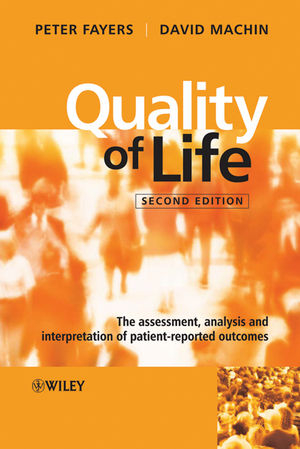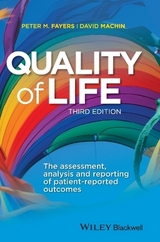
Quality of Life
Wiley-Blackwell (Verlag)
978-0-470-02450-8 (ISBN)
- Titel erscheint in neuer Auflage
- Artikel merken
* Covers the design of instruments, the practical aspects of implementing assessment, the analyses of the data, and the interpretation of the results* Presents all essential information on Quality of Life Research in one comprehensive volume* Explains the use of qualitative and quantitative methods, including the application of basic statistical methods* Includes copious practical examples* Fills a need in a rapidly growing area of interest* New edition accommodates significant methodological developments, and includes chapters on computer adaptive testing and item banking, choosing an instrument, systematic reviews and meta analysis This book is of interest for everyone involved in quality of life research, and it is applicable to medical and non-medical, statistical and non-statistical readers. It is of particular relevance for clinical and biomedical researchers within both the pharmaceutical industry and practitioners in the fields of cancer and other chronic diseases.
Reviews of the First Edition - Winner of the first prize in the Basis of Medicine Category of the BMA Medical Book Competition 2001: "This book is highly recommended to clinicians who are actively involved in the planning, analysis and publication of QoL research." CLINICAL ONCOLOGY "This book is highly recommended reading." QUALITY OF LIFE RESEARCH
Peter Fayers, University of Aberdeen Medical School, UK, Norwegian University of Science and Technology (NTNU), Tronheim, Norway David Machin, Division of Clinical Trials and Epidemiological Sciences, National Cancer Center, Singapore, School of Health and Related Research, University of Sheffield, England United Kingdom Children's Cancer Study Group (UKCCSG), University of Leicester,UK
Preface to the first edition. Preface to the second edition. List of abbreviations. Part A. Introduction. 1. Introduction. 1.1 Patient-reported outcomes? 1.2 What is quality of life? 1.3 Historical development. 1.4 Why measure quality of life? 1.5 Which clinical trials should assess quality of life? 1.6 How to measure quality of life. 1.7 Instruments. 1.8 Conclusions. 2. Principles of measurement scales. 2.1 Introduction. 2.2 Scales and items. 2.3 Constructs and latent variables. 2.4 Indicator variables and causal variables. 2.5 Single global questions versus multi-item scales. 2.6 Single-item versus multi-item scales. 2.7 Psychometrics and item response theory. 2.8 Psychometric versus clinimetric scales. 2.9 Sufficient causes and necessary causes. 2.10 Discriminative, evaluative and predictive instruments. 2.11 Measuring quality of life: indicator or causal items? 2.12 Conclusions. Part B. Developing and Testing Questionnaires. 3. Developing a questionnaire. 3.1 Introduction. 3.2 General issues. 3.3 Defining the target population. 3.4 Item generation. 3.5 Qualitative methods. 3.6 Forming scales. 3.7 Multi-item scales. 3.8 Wording of questions. 3.9 Face and content validity of the proposed questionnaire. 3.10 Pre-testing the questionnaire. 3.11 Strategies for validation. 3.12 Translation. 3.13 Field testing. 3.14 Conclusions. 3.15 Further reading. 4. Scores and measurements: validity, reliability, sensitivity. 4.1 Introduction. 4.2 Content validity. 4.3 Criterion validity. 4.4 Construct validity. 4.5 Reliability. 4.6 Sensitivity and responsiveness. 4.7 Conclusions. 5. Multi-item scales. 5.1 Introduction. 5.2 Significance tests. 5.3 Correlations. 5.4 Construct validity. 5.5 Cronbach's α and internal consistency. 5.6 Implications for causal items. 5.7 Conclusions. 6. Factor analysis and structural equation modelling. 6.1 Introduction. 6.2 Correlation patterns. 6.3 Path diagrams. 6.4 Factor analysis. 6.5 Factor analysis of the HADS questionnaire. 6.6 Uses of factor analysis. 6.7 Applying factor analysis: choices and decisions. 6.8 Assumptions for factor analysis. 6.9 Factor analysis in QoL research. 6.10 Limitations of correlation-based analysis. 6.11 Causal models. 6.12 Confirmatory factor analysis and structural equation modelling. 6.13 Conclusions. 6.14 Further reading and software. 7. Item response theory and differential item functioning. 7.1 Introduction. 7.2 Item characteristic curves . 7.3 Logistic models. 7.4 Fitting item response theory models: tips. 7.5 Test design. 7.6 IRT versus traditional and Guttman scales. 7.7 Polytomous item response theory models. 7.8 Differential item functioning. 7.9 Quantifying differential item functioning. 7.10 Exploring differential item functioning: tips. 7.11 Conclusions. 7.12 Further reading and software. 8. Item banks, item listing and computer-adaptive tests. 8.1 Introduction. 8.2 Item bank. 8.3 Item calibration. 8.4 Item linking and test equating. 8.5 Test information. 8.6 Computer-adaptive testing. 8.7 Stopping rules and simulations. 8.8 Computer-adaptive testing software. 8.9 Unresolved issues. 8.10 Computer-assisted tests. 8.11 Conclusions. 8.12 Further reading. Part C. Clinical Trials. 9. Choosing and scoring questionnaires. 9.1 Introduction. 9.2 Generic versus specific. 9.3 Finding instruments. 9.4 Choice of instrument. 9.5 Adding ad-hoc items. 9.6 Scoring multi-item scales. 9.7 Conclusions. 9.8 Further reading. 10. Clinical trials. 10.1 Introduction. 10.2 Basic design issues. 10.3 Compliance. 10.4 Administering a quality-of-life assessment. 10.5 Recommendations for writing protocols. 10.6 Standard operating procedures. 10.7 Summary and checklist. 11. Sample sizes. 11.1 Introduction. 11.2 Significance tests, p-values and power. 11.3 Estimating sample size. 11.4 Comparing two groups. 11.5 Comparison with a reference population. 11.6 Equivalence studies. 11.7 Choice of sample size method. 11.8 Multiple endpoints. 11.9 Specifying the target difference. 11.10 Sample size estimation is pre-study. 11.11 Attrition. 11.12 Conclusion. 11.13 Further reading. Part D. Analysis of QoL Data. 12. Cross-sectional analysis. 12.1 Types of data. 12.2 Comparing two groups. 12.3 Adjusting for covariates. 12.4 Changes from baseline. 12.5 Analysis of variance. 12.6 Analysis of variance models. 12.7 Graphical summaries. 12.8 Endpoints. 12.9 Conclusions. 13. Exploring longitudinal data. 13.1 Area under the curve. 13.2 Graphical presentations. 13.3 Tabular presentations. 13.4 Reporting. 13.5 Conclusions. 14. Modelling longitudinal data. 14.1 Preliminaries. 14.2 Auto-correlation. 14.3 Repeated measures. 14.4 Other situations. 14.5 Modelling versus area under the curve. 14.6 Conclusions. 15. Missing data. 15.1 Introduction. 15.2 Types of missing data. 15.3 Why do missing data matter? 15.4 Missing items. 15.5 Methods for missing items within a form. 15.6 Missing forms. 15.7 Methods for missing forms. 15.8 Comments. 15.9 Degrees of freedom. 15.10 Sensitivity analysis. 15.11 Conclusions. 15.12 Further reading. 16. Practical and reporting issues. 16.1 Introduction. 16.2 The reporting of design issues. 16.3 Data analysis. 16.4 Elements of good graphics. 16.5 Some errors. 16.6 Guidelines for reporting. 16.7 Further reading . Part E. Beyond Clinical Trials. 17. Quality-adjusted survival. 17.1 Introduction. 17.2 Preferences and utilities. 17.3 Multi-attribute utility measures. 17.4 Utility-based instruments. 17.5 Quality-adjusted life years. 17.6 Q-TWiST. 17.7 Sensitivity analysis. 17.8 Prognosis and variation with time. 17.9 Healthy-years equivalent. 17.10 Conclusions. 18. Clinical interpretation. 18.1 Introduction. 18.2 Statistical significance. 18.3 Absolute levels and changes over time. 18.4 Threshold values: percentages. 18.5 Population norms. 18.6 Minimal clinically important difference. 18.7 Impact of state of quality of life. 18.8 Changes in relation to life events. 18.9 Effect size. 18.10 Effect sizes and meta-analysis. 18.11 Patient variability. 18.12 Number needed to treat. 18.13 Conclusions. 18.14 Further reading. 19. Meta-analysis. 19.1 Introduction. 19.2 Defining objectives. 19.3 Defining outcomes. 19.4 Literature searching. 19.5 Assessing quality. 19.6 Summarising results. 19.7 Measures of treatment effect. 19.8 Combining studies. 19.9 Forest plot. 19.10 Heterogeneity. 19.11 Publication bias and funnel plots. 19.12 Conclusions. 19.13 Further reading. Appendix Examples of Instruments. Generic instruments. [L, flush left]E1 Sickness Impact Profile (SIP). E2 Nottingham Health Profile (NHP). E3 Health Survey Standard Version (SF-36v2). E4 EuroQoL (EQ-5D). E5 Patient Generated Index (PGI). Disease-specific instruments. E6 European Organisation for Research and Treatment of Cancer (EORTC QLQ-C30). E7 EORTC Head and Neck Module (EORTC H&N35). E8 Functional Assessment of Cancer - General version (FACT-G). E9 Rotterdam Symptom Checklist (RSCL). E10 Quality of Life in Epilepsy (QOLIE-89). E11 Paediatric Asthma Quality of Life Questionnaire (PAQLQ). Domain-specific instruments. E12 Hospital Anxiety and Depression Scale (HADS). E13 Short Form McGill Pain Questionnaire (SF-MPQ). E14 Multidimensional Fatigue Inventory (MFI-20). ADL and disability. E15 Barthel Index of disability (modified) (BI). Statistical tables. T1 Normal distribution. T2 Normal distribution - percentage points. T3 t-distribution. T4 ?2 distribution. T5 F-distribution. References. Index.
| Verlagsort | Hoboken |
|---|---|
| Sprache | englisch |
| Maße | 179 x 255 mm |
| Gewicht | 1102 g |
| Themenwelt | Studium ► Querschnittsbereiche ► Prävention / Gesundheitsförderung |
| ISBN-10 | 0-470-02450-X / 047002450X |
| ISBN-13 | 978-0-470-02450-8 / 9780470024508 |
| Zustand | Neuware |
| Haben Sie eine Frage zum Produkt? |
aus dem Bereich



